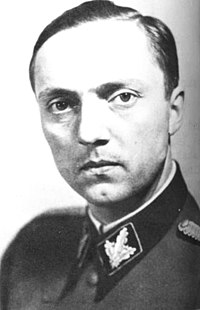Werner Naumann
This article needs additional citations for verification. (December 2019) |
You can help expand this article with text translated from the corresponding article in German. (January 2020) Click [show] for important translation instructions.
|
Werner Naumann | |
|---|---|
 | |
| Reichsminister of Public Enlightenment and Propaganda | |
| In office 30 April 1945 – 23 May 1945 | |
| Chancellor | Joseph Goebbels |
| Preceded by | Joseph Goebbels |
| Succeeded by | Office abolished |
| Personal details | |
| Born | 16 June 1909 Guhrau, Prussia, German Empire |
| Died | 25 October 1982 (aged 73) Lüdenscheid, West Germany |
| Political party | Nazi Party (1928–1945) |
Werner Naumann (16 June 1909 – 25 October 1982) was a German civil servant and politician. He was State Secretary in Joseph Goebbels' Ministry of Public Enlightenment and Propaganda during the Nazi Germany era. He was appointed head of the Propaganda Ministry by Adolf Hitler in his last will and testament after Goebbels was promoted to Reichskanzler. Naumann was present in the Führerbunker in late April 1945.
Early life and political career
Naumann was born in Guhrau in Silesia, Prussia, Germany. After finishing school, he studied political economics. Naumann joined the Nazi Party in 1928. Naumann became a member of the SA where he rose to the rank of Brigadeführer by 1933. Thereafter, Naumann joined the SS. In 1937 he was Chief of the Propaganda Office in Breslau.[1]
A year later he was made the personal aide of Joseph Goebbels and in 1942 became his assistant secretary. His official title was "Undersecretary and Chief of the Minister's Office in the Propaganda Ministry".[1] In April 1944 Naumann was named State Secretary in the Propaganda Ministry.[1] He was a member of the Freundeskreis Reichsführer SS around Heinrich Himmler and served in the Waffen-SS during World War II.[citation needed]
In the final days of Nazi Germany as Soviet forces took Berlin, he was appointed Propaganda Minister in the Flensburg government of Karl Dönitz by Hitler's Testament of 29 April 1945. On 1 May 1945, he was the leader of break-out group number 3 from the Führerbunker in Berlin. The group included Martin Bormann, Hans Baur, Ludwig Stumpfegger and Artur Axmann.[2] Erich Kempka testified at Nuremberg that he had last seen Naumann walking a metre (a yard) in front of Bormann when a Soviet rocket exploded by Bormann while crossing the Weidendammer Bridge under heavy fire in Berlin.[3] According to Axmann, the group followed a Tiger tank that spearheaded the first attempt to storm across the bridge, but it was destroyed. Bormann, Stumpfegger and himself were "knocked over" when the tank was hit.[4] Axmann crawled to a shellhole where he met up again with Naumann, Bormann, Baur, and Stumpfegger; they all made it across the bridge.[5] From that group, only Naumann and Axmann escaped from the Soviet Red Army encirclement of Berlin and made it to western Germany.[6]
Later life and death
Following Germany's defeat, Naumann lived under an assumed name for five years. He re-emerged after the 1950 amnesty and resumed his contacts within the far-right, including Hans-Ulrich Rudel, Ernst Achenbach, Artur Axmann, Otto Skorzeny and many others.[7] They infiltrated the Free Democratic Party for a period of about two years. Naumann was arrested by the British Army on 16 January 1953 for being the leader of a Neo-Nazi group that attempted to infiltrate West German political parties;[a] for which he was banned for life from standing for election as an "offender" under a new clause added to the constitution by Adenauer's government. One survivor, Bernt Engelmann observed the Zwangsdemokrat ("forced democrat") was only pretending.[8] He was released after seven months in custody. Later on, he became director at a metal firm in Lüdenscheid owned by Goebbels' stepson Harald Quandt. Naumann's own book Nau Nau gefährdet das Empire? was published by Dürer Haus in 1953. Dürer became a banned agency, but maintained operations in Argentina.[citation needed]
He died in 1982 in Lüdenscheid, West Germany, aged 73.[1] Neumann was buried in the Kommunal cemetery of Piepersloh, Werkhagener Strasse in Lüdenscheid.[9]
Notes
References
Citations
- ^ a b c d Joachimsthaler 1999, p. 301.
- ^ O'Donnell 1978, p. 298.
- ^ O'Donnell 1978, p. 301.
- ^ Beevor 2002, pp. 382, 383.
- ^ O'Donnell 1978, pp. 302–304.
- ^ O'Donnell 1978, p. 336.
- ^ Tauber 1967, pp. 133–135.
- ^ Bert Engelmann, Deutschland ohne Juden. Eine Bilanz (German) Deutscher Taschenbuch Verlag (1974), ISBN 978-3423009799.
- ^ "Naumann, Hugo Robert "Werner"". WW2 Gravestone. Retrieved 30 July 2021.
Bibliography
- Beevor, Antony (2002). Berlin: The Downfall 1945. London: Viking-Penguin Books. ISBN 978-0-670-03041-5.
- Joachimsthaler, Anton (1999) [1995]. The Last Days of Hitler: The Legends, the Evidence, the Truth. Trans. Helmut Bögler. London: Brockhampton Press. ISBN 978-1-86019-902-8.
- O'Donnell, James Preston (1978). The Bunker: The History of the Reich Chancellery Group. Boston: Houghton Mifflin. ISBN 978-0-395-25719-7.
- Tauber, Kurt (1967). Beyond Eagle and Swastika: German Nationalism Since 1945. Middletown, Conn.: Wesleyan University Press.
- Walters, Guy (2016). Naumann's War: The Life of Werner Naumann from 1909 to 1945.
- Newspaper clippings about Werner Naumann in the 20th Century Press Archives of the ZBW
